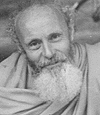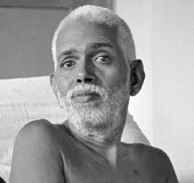Sacred
mountains are central to certain religions and are the subjects of many
legends. For many, the most symbolic aspect of a mountain is the peak because
it is believed that it is closer to heaven or other religious worlds. Some
believe that the higher one goes up a mountain, the greater the speed of
vibration and rarefied purity. This is the reason that saints and sadhus often
choose caves and hermitages near a mountain’s summit.
However
in the case of Arunachala Sri Ramana Maharshi declared that there no difference
in the power of Arunachala between the first, second or third part of the Hill.
Notwithstanding, throughout the recorded history of Arunachala; Gods, saints,
sages and the pious have made ashrams, retreats and homes on the slopes of the
Hill. In the Skanda Purana, the Goddess Parvathi joins with Sage Gautama in an ashram
believed to be the current location of Pavala Kundru on the Coral Hill spur of
Arunachala.
There
is little information available on lady saints who have come and performed
intense sadhana at Arunachala. In the 40s and 50s several eminent ladies
occupied hermitages and caves on the South East slope of Arunachala. Amongst
these women was the revered and highly respected Lakshmi Devi who dressed in
saffron and lived on the mountain. Lakshmi Devi kept a vow of silence for 12
years and responded by making signs in answer to questions from a constant
stream of visiting devotees and pilgrims. At the end of a 12 year vow of
silence she returned to her native place near Mysore. However her love of the
peace she experienced at Arunachala drew her back and she returned to the caves
and hermitages of the mountain.
Another
sadhaka who lived on the Hill during the same time period was Srimati Radhabai
Ammeyar, who was known as Ammal of Vadalur. Ammal was a faithful disciple of
Ramalinga Swamigal and originally she and Lakshmi Devi shared a cave but Ammal
eventually moved to a small rocky cleft higher up the hill. The little cave was
so low and narrow one had to remain seated, and even then one's head
practically touched the roof.
Ammal
of Vadalur, always wore white, and lived in the rocky cleft for three years in
perfect silence, her only possessions being an oil lamp and a book of the hymns
of her Master Ramalinga. She took a daily meal during the afternoon which
consisted of a few handfuls of rice-flour, roasted and mixed with curd. After
three years she moved into a small nearby hut with a women disciple. Ammal of
Vadalur was also much revered and visited during her time at Arunachala.
The
below is a narrative by Swami Abhishiktananda about an exceptional woman sadhu
named Sundarammal and of her
journey to Sri Ramana Maharshi, and who also spent time living in a cave on the Hill.
Sundarammal Journey to Sri Ramana Maharshi
"During
April, 1953, Sundarammal arrived [at Arunachala] to spend forty-eight days in
retreat in a hut close to that of Lakshmi Devi, for whom she had a great
admiration. We were thus living very close to each other, but apart from the
customary greetings, neither she nor I made any attempt to get into
conversation.
One
day, towards the end of her retreat, she invited me and some other sadhus to
share a meal at her cell. It was the Telugu New Year's Day. It was then, before
the meal began, that she told me her story.
She
belonged to a wealthy Telugu family of Madras. She married young but very soon
lost her husband. As a widow, she continued to live at home, surrounded by the
love of her parents and brothers. She rarely went out, and when she did, it was
always with her father. One day he took her to the neighbouring temple to hear
a talk given by a sadhu. This sadhu was a devotee of the Maharshi. He told his
audience about the sage's 'conversion', his disappearance from the world
[leaving Madurai], his resort to the mountain of Arunachala, and the rest.
Sundarammal was deeply moved. She begged her father to allow her to accompany
some pilgrims to Arunachala. He refused, but promised that he would soon take
her there himself.
But
the promise was not fulfilled. Sundarammal passed the time thinking of Ramana
and praying to him. She soon lost her appetite and was unable to sleep. But her
father always had some specially urgent work which prevented him from taking
her to Tiruvannamalai. One
afternoon, about four o'clock, she seemed to see Ramana coming down the
mountain and approaching her. "Sundarammal, have no fear!" he said to
her. "It is I. Enough of this weeping and not eating or sleeping. Come, I
am expecting you." Her heart was filled with joy. Once more she appealed
to her father, and once more he put off the pilgrimage to another day.
Some
weeks later, she was alone one night in her room, weeping and calling on the
Maharshi. Then, quite worn out, she fell asleep. Suddenly she felt a blow on
her side and awoke with a start. It was about three o' clock in the morning.
There was the Maharshi standing by the head of her cot. "Come," was
all he said. She
followed him downstairs, crossed the hall and came out on the verandah. Hardly
had she reached it when to her alarm she found herself alone. The Maharshi had
disappeared. She sat down uneasily.
Soon
a rickshaw appeared and the rickshaw puller said: "Is this Number 12, and
are you Sundarammal? An old sadhu told me to come here and take you to the bus.
Get in." Sundarammal thought quite simply, "It is Bhagavan, the
Maharshi," and got into the rickshaw. At
the bus stand she and the rickshaw puller were both surprised not to find the
old sadhu. However, she asked for the Tiruvannamalai bus and got in.
Somewhere
on the way her bus passed another one from which someone alighted and then
entered the Tiruvannamalai bus. "Are you Sundarammal?" he asked.
"Yes, I am," she replied. "Good. Bhagavan has sent me to look
for you." In
the evening she reached Tiruvannamalai and retired for the night in one of the
large halls kept for pilgrims. She prepared a cake to offer to Bhagavan and
fell asleep full of joy. The
next morning she went to the Ashram and fell at the feet of Bhagavan.
"Here you are at last," he said to her.
Some
days later her brothers arrived, unable to understand how this child, who by
herself had never set foot outside her home, could have managed to reach
Tiruvannamalai. But Sundarammal was so deeply absorbed that she never even saw
her brothers, either in the hall or at midday in the dining hall. Only in the
evening were they able to approach her. They told her how upset everyone was at
home and begged her to return. If she wanted, they would build her a hermitage
in the garden. But nothing moved her and the brothers even spoke of taking her
home by force. "If you do, I will throw myself into a well," she
said. Her brothers had to yield, but they soon returned with their father. They
found her in a cottage near the Ashram and arranged for her continued stay
there as well as they could.
During
the fifteen years that remained of the Maharshi's life, she never left
Tiruvannamalai even for a day.
 |
| Sundarammal |
This
was the story that Sundarammal told me that morning — Sundarammal who could
never speak of God without her voice breaking with emotion and her eyes filling
with tears."
[Narrative Swami Abhishiktananda]








